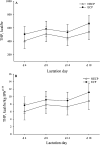Electronically controlled cooling pads can improve litter growth performance and indirect measures of milk production in heat-stressed lactating sows
- PMID: 34932814
- PMCID: PMC8903144
- DOI: 10.1093/jas/skab371
Electronically controlled cooling pads can improve litter growth performance and indirect measures of milk production in heat-stressed lactating sows
Abstract
Heat stress (HS) decreases lactation output in sows due to an attempt to reduce metabolic heat production. However, this negatively affects litter growth performance. Therefore, the study objective was to determine whether electronically controlled cooling pads (ECP) would improve indirect measures of lactation output (e.g., total heat production [THP]) and litter growth performance in HS exposed sows. Over two repetitions, 12 multiparous (2.69 ± 0.85) lactating sows (265.4 ± 26.1 kg body weight [BW]) and litters were assigned to either an ECP (n = 3/repetition) or a non-functional ECP (NECP; n = 3/repetition) and placed into farrowing crates within indirect calorimeters from days 3.7 ± 0.5 to 18.7 ± 0.5 of lactation. Litters were standardized across all sows (11.4 ± 0.7 piglets/litter), and sows were provided ad libitum feed and water. All sows were exposed to cyclical HS (28.27 ± 0.26 °C nighttime to 33.09 ± 0.19°C daytime). On days 4, 8, 14, and 18 of lactation, indirect calorimetry was performed on each individual sow and litter to determine THP and THP/kg BW0.75. Body temperature (TB) was measured hourly using vaginal implants, and respiration rate (RR; breaths per minute [bpm]) was measured daily at 0700, 1100, 1300, 1500, and 1900 h. Sow feed intake (FI) was assessed daily. Litter weights were obtained at birth, on days 4, 8, 14, and 18 of lactation, and at weaning. Data were analyzed using PROC GLIMMIX with sow and/or litter as the experimental unit. An overall decrease (P < 0.01; 25 bpm) in RR and maximum daily TB (P = 0.02; 0.40 °C) was observed in ECP vs. NECP sows. An increase in THP (P < 0.01; 20.4%) and THP/kg BW0.75 (P < 0.01; 23.1%) was observed for ECP when compared with NECP sows and litters. Litter average daily gain and weaning weight were increased (P < 0.05; 25.0 and 19.2%, respectively) for ECP vs. NECP litters. No FI differences were observed (P = 0.40) when comparing ECP (5.66 ± 0.31 kg/d) and NECP (5.28 ± 0.31 kg/d) sows. In summary, ECPs improve litter growth, thermoregulatory measures, and bioenergetic parameters associated with greater milk production in lactating sows exposed to cyclical HS.
Keywords: cooling pad; heat stress; lactation; mitigation; pigs; sows.
Plain language summary
Lactating sows are heat stress sensitive due to greater feed intake and metabolic heat production to support milk production. Therefore, heat-stressed lactating sows reduce their feed intake and undergo physiological changes that prioritize survival over productivity which reduces milk production. Reduced milk production has negative downstream effects on the litter and can decrease litter growth performance and health status. The negative effects of heat stress on lactating sows may be ameliorated by using electronically controlled cooling pads. Electronically controlled cooling pads improve the ability of lactating sows to maintain a normal body temperature under heat stress conditions. However, it is unknown whether these pads can improve lactating sow feed intake, milk production, and subsequently litter performance under heat stress conditions. It was determined that electronically controlled cooling pads were effective in increasing piglet body weight gain and weaning weight and increasing indirect measures of sow milk production independent of greater sow feed intake. In addition, the electronically controlled cooling pads allowed sows to maintain a normal body temperature under heat stress conditions. These data suggest that electronically controlled cooling pads can be an effective technology to improve lactating sow and litter performance under heat stress conditions.
Published by Oxford University Press on behalf of the American Society of Animal Science 2021.
Figures




References
-
- Baumgard, L. H., Abuajamieh M. K., Stoakes S. K., Sanz Fernandez M. V., Johnson J. S., and Rhoads R. P.. . 2014. Feeding and managing cows to minimize heat stress. Proc. 23rd Tri-State Dairy Nutrition Conference, Fort Wayne, IN. Ohio State University, Ames. pp. 61–74.
-
- Black, J. L., Mullan B. P., Lorschy M. L., and Giles L. R.. . 1993. Lactation in the sow during heat stress. Livestock Prod. Sci. 35: 153-170. doi: 10.1016/0301-6226(93)90188-N - DOI
-
- Brito, L. F., Oliveira H. R., McConn B. R., Schinckel A. P., Arrazola A., Marchant-Forde J. N., and Johnson J. S.. . 2020. Large-Scale phenotyping of livestock welfare in commercial production systems: a new frontier in animal breeding. Front. Genet. 11:793. doi:10.3389/fgene.2020.00793 - DOI - PMC - PubMed
-
- Brown-Brandl, T. M., Hayes M. D., Xin H., Nienaber J. A., and Li H.. . 2014. Heat and moisture production of modern swine. ASHRAW Trans. 120: 469-489. doi: 10.13031/trans.57.10711 - DOI
-
- Cabezon, F. A., Field T. C., Winslow E., Schinckel A. P., and Stwalley R. M. III. 2021. Computerized data acquisition to demonstrate the influence of coil density on hog cooling pad heat transfer and long-tern operational sustainability. Int. J. Ag. Sci. 11: 1–17. doi:10.46882/ijas/1438 - DOI
MeSH terms
Grants and funding
LinkOut - more resources
Full Text Sources
Medical

